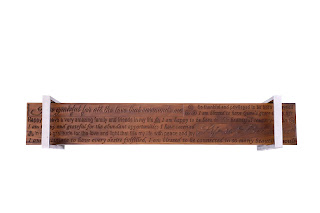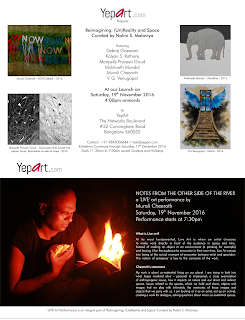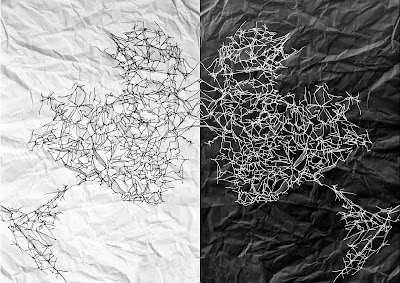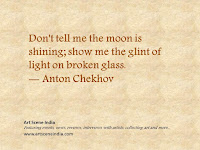Intersections of Infinite Possibilities
Shraddha Rathi explores the concept of gratitude, an expressive emotion towards an appreciation of life and for tangible and intangible gifts, in her new suite of works. She creates a narrative which is rich in emotional content and universal in its reach. From personal notes to community messages, the expanse of storytelling weaves a rich tapestry of chronicles, patterns and motifs of human sentiments, moments and memories.
Adopting a multi-media approach, Rathi, a practicing artist for more than fifteen years now, presents photographs, installations, paintings and a video projection in this exhibition. With this series, she emerges from the confines of traditional bounds and expands her artistic and conceptual horizons to put forth a body of work that has meaningful associations on a personal front and has implications for a larger context.
In a significant shift this year, she created a gratitude bench with engravings of phrases and personal messages of thankfulness and appreciation. This bench organically evolved into the present suite of works and forms the cornerstone for her current engagement. Coincidentally, earlier this year she sighted the benches in Central Park, New York with their plaques that read out messages of gratitude, love, celebration and nostalgia.
Thus, innumerable stories that are intimate and personal, which celebrate the joy of living and memories of life and loved ones, and that effectively translate this personal form of gratitude into community efforts, have coalesced to materialise in the artworks for Rathi’s exhibition. Photographs of plaques, benches and the surrounding landscape from Central Park form the artwork. In addition, inscribed messages on wooden benches, swings and a see-saw, and a video projection mapping of gratitude notes that projects the text onto various surfaces, including the witness/participant, are on display. Contextualising and integrating the notion of gratitude and its universality to Bangalore’s public spaces, conceptual maps of parks are represented in the paintings. The minimalist mappings offer points of reference to local contexts and create possibilities of artistic interventions.
The theoretical premise behind ‘Grazie Infinite’ is two-fold, to reiterate and acknowledge positivity as an indispensable emotion and to extend this engagement via site specific projects to the public arena. Rathi’s practice with this shift towards conceptual art and a minimalist aesthetics lies at the intersections of infinite possibilities, employing mixed media narratives and interactive experiences, while situating them within and outside the frameworks of conventional art locations.
Nalini S Malaviya
Art Critic
Bangalore, July, 2018
All images are courtesy the artist
Please share this article using the social media widgets at the bottom and do subscribe to receive regular updates from Art Scene India.
To contribute articles, please get in touch at nalini.indianart@gmail.com
Also read,
- Art Mumbai: Written on Water curated by Sanjeev Sonpimpare
- Reasons To Visit The 2017 Venice Biennale by Shraddha Rathi
- Art and the Question of Authorship and Ownership in the Internet Era by Narendra Raghunath
- The 'Reality' of Photo Art Today by Shibu Arakkal
- A Tribute to Artist M.B. Patil by H.A. Anil Kumar
- Art News: apexart Open Call for Group Exhibitions 2018-19
- 5 Reasons a Good Catalogue Text is Essential for Your Art
- How To Write An Artist Statement
- 6 Tips On How To Approach An Art Gallery And Find Gallery Representation
- Exhibiting Art in Non-Gallery Spaces
- Guide To Exhibiting Your Artworks
- How to Create an Online Presence

















